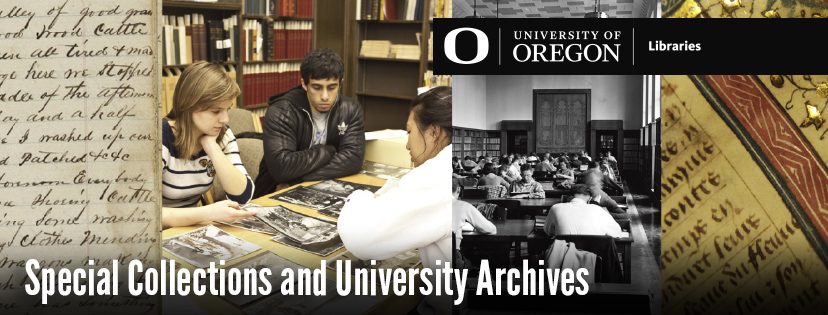Bringing Persia to the Pacific Northwest
This is the third of a series of blog posts that will explore exhibits during the 1960s at the Museum of Art at the University of Oregon, known today as the Jordan Schnitzer Museum of Art. Part of the Documenting UO History Project, this series will investigate two major types of exhibits: the Statewide Services Program and national exhibits that traveled to the Museum. The University Archives collection of the Museum’s records, cross referenced with the Jordan Schnitzer’s current holdings, reveal a unique institutional history of the Museum, its exhibits, and its employees. Though the Jordan Schnitzer’s current focus is on Asian art, and the Museum of Art also worked to complement its Asian collection, this project will focus on a variety of other kinds of exhibit subjects. See previous posts here.
What is the longest distance art has traveled to arrive in Eugene? Art pieces from modern-day Iran and India certainly fit the bill! The Portland Art Museum showed an exhibition of Persian and Indian miniature paintings in November 1963. This group of pieces from famed American collector Edwin Binney traveled up and down the West Coast, and they visited the Museum of Art at the University of Oregon at the end of 1963.
Similar to the illuminated manuscripts of medieval England, these miniatures from the Binney Collection decorated the pages of books from Persian and Indian empires. The pieces remain as eye-catching and lively as they were when painted in the 15th and 16th centuries! Their bright colors depict battles, animals, and portraits of people. On the same page, elegant flowing script tells the stories of the paintings. These books would have been owned by wealthy and important people. They could afford to pay the artisans who crafted the books by hand. These miniature artworks represented a unique time in the region’s history, but were not often on public display in the Pacific Northwest.
As in previous posts for this blog, we visit the University of Oregon Museum of Art in the 1960s to learn about its exhibitions. In his letters to other museum professionals, Museum director Wallace Baldinger expressed how excited he was that his museum would host Binney’s “Persian and Indian Miniatures” exhibition. Baldinger wanted to show it both to the public and to University of Oregon students, as well as give visual examples to his class on the History of Oriental Art.
Before the exhibit arrived in Eugene, Baldinger negotiated bringing an eminent British curator from the Victoria and Albert Museum in London. This curator, W. G. “Bill” Archer, would lecture on Indian art from the time period. It remains typical for today’s museums to coordinate these kinds of art lectures; they provide additional details and context to assist the public’s understanding of the artwork. Archer had been to Portland to see the Binney exhibit and wanted to give a talk called “The Loves of Krishna.” Unsurprisingly, Baldinger delightedly seized this opportunity because Archer was famous for his research on the topic. After some negotiations with the University about paying Archer for his time, they scheduled the lecture for early November 1963.
The two men wanted to promote Archer’s visit to ensure good attendance at his lecture. In letters from September 1963, Baldinger asked Archer for details about the lecture. He wanted to know the outline of the talk, what kind of art slides Archer would use, and other details in order to publicize the event. Remember, one couldn’t simply share a Google Slides presentation – airmail was the two men’s main method of communication. The Museum of Art wanted to emphasize the importance of Archer’s visit because of Archer’s impressive resume. Accommodations were made for the visit of both Archer and his wife Mildred. Surprisingly, she went by ‘Tim,’ but was quite famous in her own right as an art historian of India. The lecture would be a huge hit and the exhibit went off without a hitch. Museums are often responsible for safely shipping shows to another museum or gallery. The Museum of Art sent the exhibit on to California’s Oakland Museum of Art, its next stop.
Extraordinarily, the original donor of the pieces in the traveling exhibit decided to contribute some of his collection to the Museum of Art! During the last months of 1963, Edwin Binney 3rd corresponded with Baldinger in order to gift six objects to the museum’s collection. In their letters, Binney demonstrated his amusing way with words and the two men developed a good rapport. Binney felt comfortable giving the objects to the Museum of Art because of the high praise he heard about the institution from W.G. Archer and his wife.
The Archers told Binney a funny story: Mrs. Ellen Baldinger, wife of director Wallace Baldinger, went to meet the Archers at the train station when they arrived for his lecture. She assumed someone with the title “Keeper Emeritus of the Victoria and Albert Museum” would be much older. So she boldly addressed several quite elderly men if they were Mr. Archer – however, Bill and Tim Archer were in their early 60s! Once Ellen Baldinger found Bill and Tim, they all found it very entertaining. This endorsement is one of the reasons Binney decided to work with Baldinger.
Because he was a collector, one would never assume that Edwin Binney 3rd was also the heir to the entire fortune of the Crayola founder, Edwin Binney! After graduating from Harvard, the younger Binney cultivated his money and his time towards researching and collecting extraordinary pieces of Indian art. Items he donated can be found at museums across the country, from Portland to San Diego. Perhaps most importantly, today we can view online the items he donated to the museum and know that the art has both ancient and recent historical value.
Angela Rothman
Special Collections Intern
Documenting UO History Project

